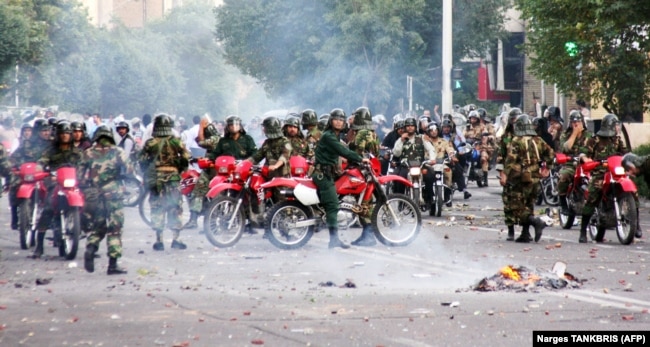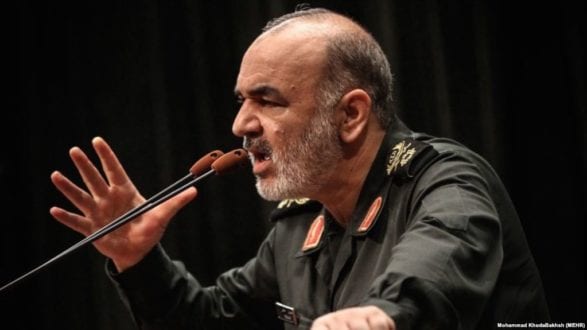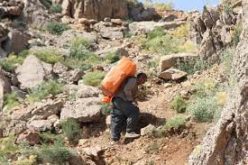Radiofarda – Iran’s Revolutionary Guard (IRGC) commander Hossein Salami appointed Brigadier General Gholamhossein Gheybparvar as his deputy at the Central Security Headquarters on September 7, in a likely bid to tighten security measures against possible protests.
In his new post Gheybparvar will be the commander of Imam Ali Central Security Headquarters, a unit tasked in 2011 with confronting public protests and riots. The HQ was set up in the aftermath of massive unrest in Iran after the disputed 2009 presidential elections that were challenged by the opposition and millions of people as rigged to re-elect ultraconservative president Mahmoud Ahmadinejad for a second term.
Radio Farda’s Iran analyst Morad Veisi in this analysis published on Radio Farda’s Persian website, explains the nature of the Imam Ali Central Security Headquarters and the meaning of this appointment within the context of Iran’s domestic politics.
Lessons of Suppression of 2009 Unrest
The Imam Ali Central Security Headquarters is the outcome of the Islamic Republic’s trial and error experiments in suppressing the widespread urban unrest of 2009 protests.
The IRGC’s tactic in tackling the uprising was deploying swarming motorcyclists in groups of 50 against protesters. The method took into account Tehran’s perpetually jammed traffic. The units were faster than police cars and anti-riot vehicles. In addition, as motorcycles arrived with masked riders on the back-seat whiling batons and all the noise the bikes made created havoc and intimidated the demonstrators.
The suppression of the 2009 unrest took more than a year. In the meantime, the motorcycle units passed their test and were promoted in terms of numbers, equipment and official organization in the shape of battalions that were formed in 2011. Meanwhile, smaller Basij militia units and other motorcyclists were also merged into these battalions./**/ /**/ /**/ SEE ALSO:Anatomy Of Suppression In Iran: The Institutions & Tactics That Repeatedly Quash Dissent
Then IRGC Commander Mohammad Ali Ja’afari at the time explained the mission of these units as “confronting seditions”, the official jargon meaning anti-regime protests.
Previously, the authorities depended on mobilizing Basij forces through the network of mosques. Members of the para-military force would rush to the scene of protests with whatever means they had, including vans and motorcycles, using whatever hand weapons they could find to disperse protesters.
Why Battalions?
The new kind organization based on Imam Ali battalions enables the units to act independently in their urban landscapes. They can disconnect communications and disrupt traffic when protests are serious and act without having to seek permission of higher officials. They can decide locally and act locally within their territory.
According to Jafari, some 31,000 troops have been organized as 100 battalions in various parts of Iran. The figures date back to at least four years ago, and they might have been changed since.

The battalions are part of the combat organization of the Basij which operates under the IRGC Ground Forces. They are different from the police and the IRGC special forces and begin their operations only when the police and other anti-riot units fail to effectively confront protesters.
The new organization marks the inefficiency of the Iranian police in handling the 2009 protests and the IRGC’s twenty years of experience in dealing with all forms of protests from unrest in 1999 to the 2009 protests and the widespread riots of late 2017 and early 2018.
The units have performed numerous drills and exercises to ensure their preparedness. At the same time, the obsession with suppressing protests marks the government’s growing concern over rising dissent and possible unrest.
The Man To Suppress Riots
Gholamhossein Gheibparvar is an experienced IRGC officer. He has fought in the war against Iraq in the 1980s as a junior officer. After the war, he was the commander of the IRGC’s 19th division for 3 years and then he became the commander of Fajr Division in Fars Province for 8 years.
When serving in Fars Province, Gheibparvar became known as a radical commander. He strongly opposed Western types of cultural events, such as concerts and his criticism of former pragmatic President Akbar Hashemi Rafsanjani made him popular among staunch hardliner supporters of Ayatollah Ali Khamenei. He became particularly famous when it was revealed that he had engineered an attack by plainclothes agents on outspoken lawmaker Ali Motahari during a visit to Shiraz in 2014. Motahari took him to the court, but the case remained inconclusive as one can expect.
Shortly afterwards, he was promoted thanks to Khamenei’s appreciation of his “services” and became the commander of the Basij militia. This was an important position within the IRGC.
Gheibparavar is particularly known for his radical positions on domestic politics and foreign policy. In many cases, this included direct and indirect verbal attacks on officials of the Rouhani administration.
After 3 years (2016-2019) as Basij commander, he was removed from his post and was not appointed to a higher position, which indicates Khamenei was not happy with his performance. His new appointment has been announced by IRGC Commander Hossein Salami.
In his new position, he is tasked with expanding the Imam Ali Central Security Headquarters model from Tehran to other parts of the country and oversee the establishment of motorcycle units in all Iranian cities to suppress possible urban protests.
Gheibparavar is now the commander of one of the most up-to-date, rapid-response anti-riot forces in Iran to address the regime’s concerns over possible urban riots. Ayatollah Khamenei, whose interest in running the country’s affairs using military structures is well known, has given the control of one of his most sensitive security headquarters to one of his most politically-minded radical commanders.
 Shabtabnews In this dark night, I have lost my way – Arise from a corner, oh you the star of guidance.
Shabtabnews In this dark night, I have lost my way – Arise from a corner, oh you the star of guidance.



